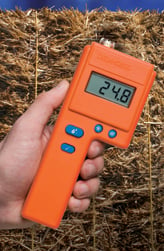Hay might not be the most glamorous thing that a farmer grows, but it is one of the most important crops for keeping the entire farming industry going. Just as a primary source of feed for various farm animals, hay is a vital crop.
However, it is important for hay to be of a high quality before attempting to feed it to a grazing animal, or else the animal might not eat it or worse, eat it and get sick from it. But, what makes for high-quality hay that will be of benefit to an animal, and how do moisture meters figure into the creation of hay?
The key factors that determine the quality of a given sample of hay include:
1. The Species of Plant That the Hay Comes from:
Not all hay is grass, after all. Hay can be made from any herbaceous plant (plants with leaves and stems that die at the end of their growing season and lacks a wooden trunk), and different herbs have different inherent nutritional values as a base for hay. While grass, particularly fescue and orchardgrass, are frequently used for hay, certain legumes (bean plants) such as alfalfa are more nutritious and desirable.
Using healthier, nutrient-rich plants for hay helps to ensure that the hay produced is of the best quality possible.
2. Timing of the Harvest
Cutting the plants just prior to the seeds of the plants becoming ripe often results in better quality hay. At this point, the plant’s nutritional value is at its highest, and any leafy portions of the plant are at their most robust.
If cut too soon or too late, the finished hay won’t have as much nutritional value. With the harvesting of hay, timing is of the essence.
3. Weather Conditions
For all farmers, local weather patterns can be either a great boon or a huge obstacle. When conditions are just right, crops are robust, healthy and easy to harvest.
However, Mother Nature rarely feels like being cooperative 100% of the time. If the weather is too dry, nutrients will be lost and stems will be stiff and coarse, reducing the quality of the hay. If the weather is too wet, not only can leaves be lost, the hay might spoil in the field. Which brings us to the next factor that affects hay quality:
4. Moisture Content of the Hay
Typically, hay is allowed to sit in the sun for a while before being harvested. This gives the hay a chance to lose excess moisture before it is collected into bales. If there is too much moisture in hay, it can spoil in the field before it has a chance to be used.
However, it isn’t always readily apparent that hay is too wet when it is getting baled (although there are devices that can check %MC in hay during baling). Obviously, no farmer would bale hay in monsoon-strength rain, but what about after a day or two of drying? Is that hay good to go yet? Left in the field too long, and that hay will be rendered useless anyways, so it has to be baled right away.
5. Where the Hay is Stored
The storage conditions of the hay also go a long way towards making sure that hay is top-quality. When placed in a dry, cool area that is protected from the effects of adverse weather, hay can last throughout the seasons when farmers need it most.
Stored outside, hay is subject to the fickle nature of the weather, where alternating periods of intense sunshine and rain can ruin the nutritional value of the hay. Even when stored in a silo, barn, or other protective enclosure, hay can still become ruined if the structure holding the hay is compromised with excess moisture.
Controlling Risks with Moisture Meters
 While farmers might not be able to control the weather, they can maximize their hay yield by picking the right plants to raise for the harvest and carefully timing when they reap the hay. When the weather doesn’t cooperate, however, farmers can make sure that their hay is top quality by using a variety of moisture meters to monitor the moisture content of their hay bales.
While farmers might not be able to control the weather, they can maximize their hay yield by picking the right plants to raise for the harvest and carefully timing when they reap the hay. When the weather doesn’t cooperate, however, farmers can make sure that their hay is top quality by using a variety of moisture meters to monitor the moisture content of their hay bales.
Using a resistance-type meter with extended-length probes allows farmers to get a reading of the moisture conditions deep within a hay bale. Armed with this information, a farmer will know whether that bale of hay is ready to be stored, or if it would pose too much of a health risk to any animal that it would be fed to.
Attempting to “eyeball it” can lead to enormous problems later on. A simple visual inspection of a hay bale does not provide measurement reliable indication of moisture, and can result in storing unsafe hay with good hay, compromising what should have been ready to use hay.
For these reasons, moisture meters are vital tools for farmers. With these handy tools to act as a damp detector for hay, a farmer can be confident that their hay is of the best quality possible, and not compromised by moisture.

Comments